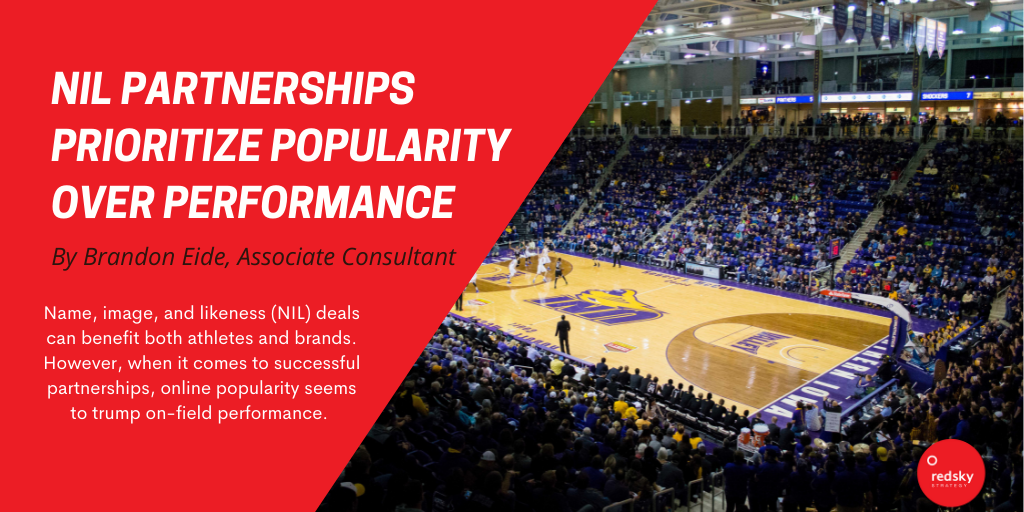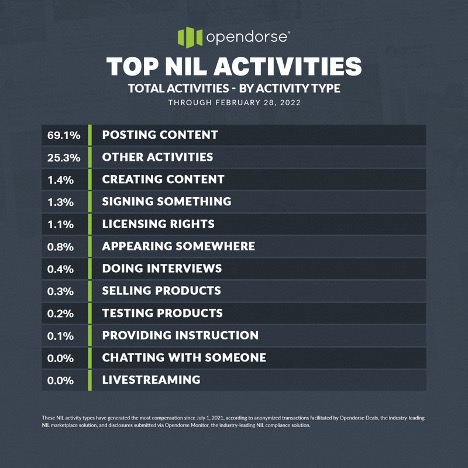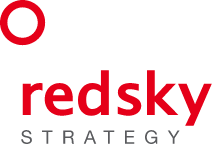News
NIL Partnerships Prioritize Popularity Over Performance

Source: https://unsplash.com/photos/WOC-DFTx8IY
Using celebrities and athletes in marketing is not a new concept. However, being able to earn a profit from brand deals is something that has only recently been introduced at the collegiate level.
Thanks to new legislation passed by the NCAA, college athletes are now able to earn an income from their name, image, and likeness (NIL). The ruling also presents brands with an opportunity to leverage these partnerships to grow their audiences and brand awareness.
Many college athletes are signing deals with companies, with NIL activities ranging from doing interviews to posting on social media:

Source: https://opendorse.com/
We’re seeing NIL deals arise from both local and national sports brands. For example, Adidas recently created a paid affiliate program for over 50,000 student-athletes, enabling any eligible student-athlete belonging to an Adidas-partnered NCAA Division 1 university to become a brand ambassador.
According to the sports brand, it’s the company’s first “wide-sweeping, equitable and inclusive” NIL program. Additional notable brands partaking in NIL deals include Boost Mobile, Icy Hot, Pepsi, Papa Johns, and Rebook.
Popularity Over Performance
What’s interesting about the NIL deals is that many of the participating athletes have produced disappointing results with their on-field performances. When it comes to NIL partnerships, it seems that brands are less concerned about the athlete’s performance on the field as they are about the athlete drawing brand awareness and promoting the business, especially on their social media platforms.
For example, last year, Alabama Quarterback Bryce Young had over 87,000 followers on Instagram (now it’s closer to 200,000) and signed more than $800,000 in NIL deals – all before starting in his first college football game.
Some of the top prospects going into this year’s NCAA tournament as well as future prospects are attracting NIL deals due, at least in part, to their rising popularity. This includes many lesser-known athletes, such as Chloe Mitchell – an NAIA volleyball player who became one of the first college athletes to profit from their NIL.
In the throes of quarantine boredom, Mitchell turned to renovating her backyard shed as a creative outlet. She documented and posted the transformation on TikTok, which led to her garnering over 2 million followers.
Soon after becoming a college athlete, the NAIA changed its NIL rules, allowing Mitchell to become the first college athlete to profit from a NIL endorsement (from a golf course). While still not considered a large-scale athlete, Mitchell has since had a handful of partnerships, yet not one of those deals has been volley-ball related.
The majority of the money in NIL deals is going to male athletes. However, social media is unlike traditional media, which is largely focused on men’s basketball and football. On social media, growth and popularity are associated more with your personality than your professional performance or media coverage of your sport.
Smaller companies have an opportunity to draw brand awareness from other college athlete influencers who have strong, more niche social media followings. They can capitalize on the NIL deals by drawing recognition and awareness for their businesses that might have otherwise been taken by the bigger, more dominant, and prominent brands.
Diversity in NIL Deals
Women and minority students are more often getting asked to be part of a brand’s campaign strategy because it presents an opportunity to demonstrate how the brand cares about diversity.
This is something moving company College HUNKS recognized and acted on by signing the Howard University men’s basketball team to an endorsement deal last year.
“Our business started as an underdog with a beat-up cargo van in college, so aligning with student-athletes that historically have not received large media attention is important to our brand purpose,” explained Nick Friedman, College HUNKS Co-Owner. “College HUNKS has a diverse team, and we strive to brighten the spotlight within and outside of our brand to build leaders and make a positive impact.”
While NIL deals are still primarily focused on men’s sports, social media helps level the playing field (so to speak) and drive media attention to women’s athletics. Hopefully, this will translate to increasing recognition for women’s sports.
Attracting the Influence of College Athletes
Influencer marketing has become an increasingly popular and effective technique across nearly every industry. When it comes to the NCAA, the athletes are the influencers.
Brands that trust in their athletes to give an honest take on issues they’re passionate about (social justice, gender pay gaps, etc.) can gain authentic brand equity. It can also help them build brand loyalists who are specially connected to the company because their favorite athlete endorses the company.
As a brand, in order to determine who your influencers will be, it’s important to consider who your target audience is as the athlete should be representative of them.
Let’s say you’re running a regional marketing campaign for a restaurant franchise. Knowing who your target audience is, how they behave, what their common attitudes are, and what social media platforms they use the most will all be crucial to the effectiveness of your campaign.
For influencer focus groups and market planning, you could run a survey to identify who and which sports are most popular within the region. From there, you could strategize for how you’ll utilize the athlete and select ambassadors based on their ability to target that audience. For example, did they grow up in the area? Are they actively involved in helping their local community?
You might also want to avoid putting all your eggs in one basket in the event that the athlete is injured or no longer performs or resonates well with your target audience. To avoid this, you could select a few different athletes and build products around them.
Interested in working with RedSky Strategy for market research and strategic planning? Our team looks forward to meeting with you and uncovering ways we can use HumanSight™ to illuminate the best pathway to growth for your company.
